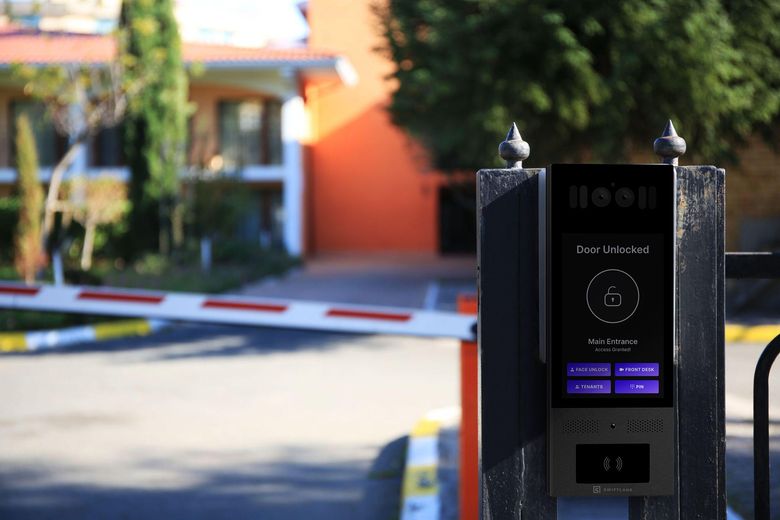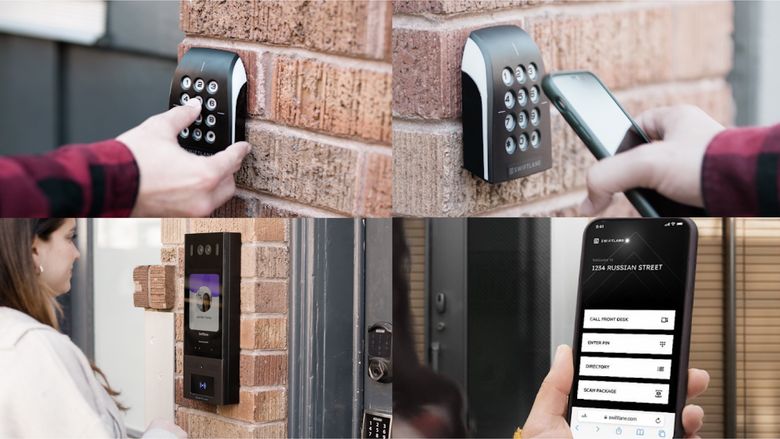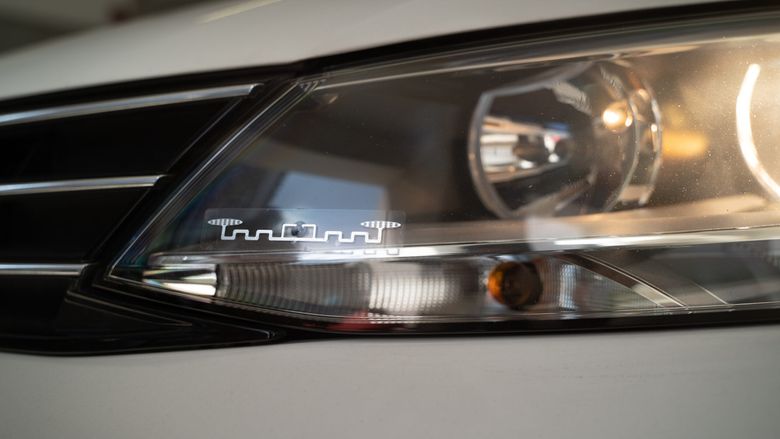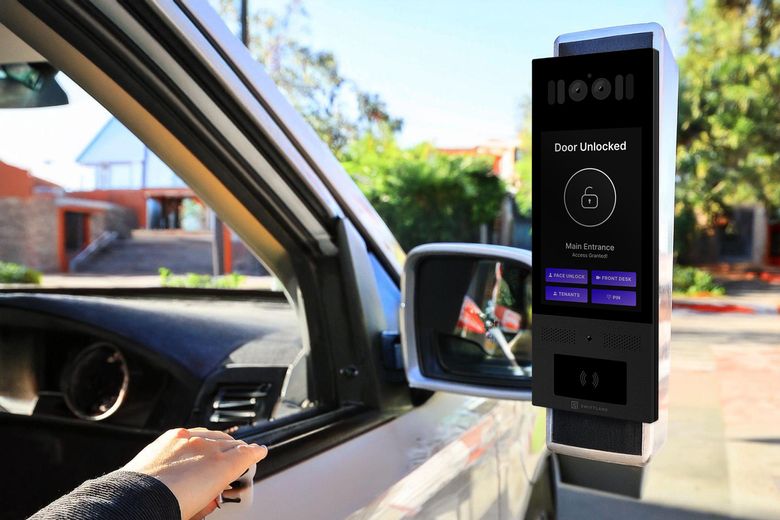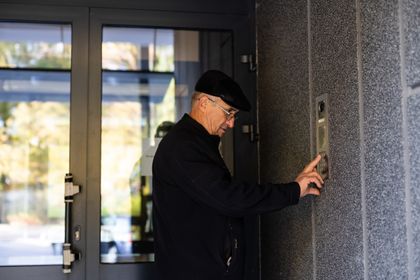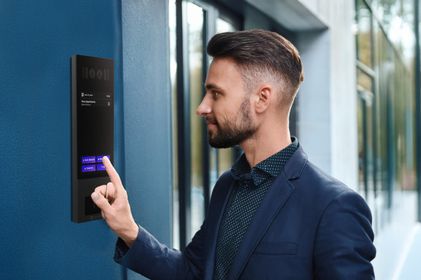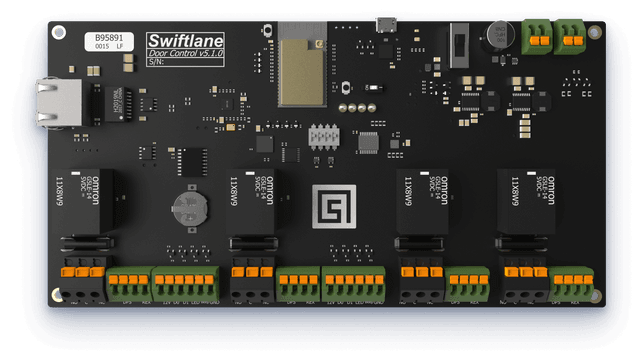Article Updated on 9th April, 2025
A gate access control system is a security solution that manages and restricts entry to a property, building, or community. It ensures that only authorized individuals, such as residents, employees, or approved visitors, can gain access. These systems can be implemented in residential communities, commercial buildings, industrial facilities, and parking structures.
When we think of gate access control, there are generally two types of gates used for buildings and facilities:
Vehicle gates: These include rotating arms, sliding gates, swinging gates, garage doors and other barriers that restrict traffic flow. They can control vehicle access to entire neighborhoods, HOAs, campuses, and multi-building facilities, or they can be used specifically to protect parking areas.
Pedestrian gates: These gates help control who can walk into certain areas of a property. Like vehicle gages, they can restrict access to an entire campus, property or HOA that is fenced or walled in. They can also be used to control access to particular outdoor facilities like pools and tennis courts, reserving them for authorized users.
This article covers access control systems that can work for both types of gates. We cover the hardware and software components that work for both residential gate access control and commercial gate access control. We explore the use cases and potential benefits. Lastly, we provide gate access control system buyer’s checklist to help you determine if a system will meet your building or facility’s needs.
Who Needs Gate Access Control Systems?
Following are use-cases of gate access control systems:
- Residential Communities & HOA Properties – Gated communities, apartment complexes, and condos use these systems for resident security. They can help keep traffic down on small residential streets, prevent unwanted solicitors, and reduce burglaries.
- Commercial Buildings – Office parks, coworking spaces, and business centers manage employee and visitor entry.
- Industrial & Warehouse Facilities – Protect restricted areas from unauthorized access. They are popular as a pedestrian and vehicle access control tool at construction sites.
- Educational Institutions – Universities and schools use these systems to control vehicle and pedestrian access, including areas of campus for students or faculty only.
- Hotels & Resorts – Ensure guests and staff have secure entry while restricting unauthorized visitors.
Benefits of a Gate Access Control System
- Enhanced Security – Prevents unauthorized access and deters crime. Reduces traffic and protects parking.
- Improved Safety – Protects residents, employees, and assets from potential threats. Reduces porch piracy – package theft – in residential neighborhoods.
- Convenience & Efficiency – Streamlines entry for authorized users with automated access. Helps buildings and neighborhoods manage increasing volumes of traffic, especially for food and package deliveries.
- Access Logging & Monitoring – Provides records of entries and exits for audit and security purposes.
- Remote Access & Integration – Many modern systems allow remote operation and integration with other security measures like CCTV.
- Customization & Scalability – Systems can be tailored to fit small properties or large corporate campuses.
- Visitor Management – Improves the process of granting temporary access to guests and service providers.
How Gate Access Control Works
The fundamental process of gate access control involves:
User Authentication: The system verifies the identity of an individual using access credentials such as a PIN code, keycard, biometric scan—typically via facial recognition—or mobile authentication. This requires a choice of hardware such as a numeric keypad, an RFID reader, or a video intercom.
Access Verification: The system checks if the user’s credential is in its database. Once authenticated, the system determines whether the individual has permission to enter the premises.
Gate Operation Control: The system grants access by unlocking or opening the gate, allowing entry only to authorized individuals. In some cases, gates may be equipped with automatic barriers, turnstiles, or remote-controlled mechanisms, so they swing open automatically, especially for vehicles..
System Logging: Many systems maintain a digital log of access activity for security audits, tracking, and real-time monitoring.
Components of a Gate Access Control System
A gate access control system helps control who can unlock a particular gate that controls vehicle or pedestrian traffic. A typical gate access control system consists of several key components:
- Gate or Barrier – The physical gate, barrier arm, or turnstile that restricts access.
- Access Credentials – Methods of verifying authorized entry, including:
- Key fobs or RFID cards
- PIN codes
- Mobile apps (Bluetooth, NFC)
- License plate recognition (LPR), barcode stickers, or RFID stickers on cars
- Biometric scanners (fingerprint, facial recognition)
- Keypad, Reader or Scanner – A device that scans access credentials or accepts PIN codes.
- Control Panel / Controller – The central system that processes authentication and controls gate operation. Sometimes, you’ll find that this controller is built into an intercom that runs the whole system.
- Intercom System (optional) – Allows visitors to communicate with security personnel or residents for manual access approval. You can mount intercoms next to a pedestrian gate or a post at driver level on a roadway.
- Camera & Surveillance (optional) – Provides video monitoring for security and record-keeping.
- Cloud-Based or On-Premise Software – Manages access permissions, logs entries, and integrates with other security systems. This is how condo and HOA boards, property owners, and property managers program who has access.
- Remote Access & Mobile App (optional) – Enables property managers, security personnel, or optionally building tenants to control access remotely. That way, tenants can remotely grant access to their guests, deliveries, and services ranging from nannies and dog walkers to house cleaners and tutors.
- Power Supply & Backup – Ensures continuous operation even during power outages.
The physical gates and the access control hardware are often sold by different manufacturers, so you can pair various access control systems with various types of gates.
Checklist: Considerations Before Choosing a Gate Access Control System
If a property manager or building owner is ready to invest in a gate access control system, they should consider the following:
Access Control Credential Types
- RFID cards/key fobs: Tap a key fob or ID card at a reader, and the gate opens.
- Keypad with PIN codes: Simply type a numeric code on a keypad (or intercom touchscreen) and the gate opens.
- Mobile access: This is fast becoming an industry standard. Residents and tenants like being able to carry just their mobile phone without wallets or keys. Many mobile apps integrate with voice commands like Siri or car assistants like CarPlay so that gates can be opened with simple commands on the phone.
- License plate recognition: A classic means of access for vehicle access, but has been replaced in recent years by RFID stickers.
- RFID windshield stickers: These adhere to the windshield, and they are detected when a car pulls up to a gate, which automatically opens.
- Biometric access: Popular with building access control (such as on front door intercoms) because unlike PINs or key fobs which can be stolen, biometrics authenticate who the person is with a fully keyless entry method. Facial recognition is popular as a hands-free and sanitary method of biometric access.
Integration with Existing Security Systems
- CCTV: You may want video cameras to record whenever someone approaches a gate. This functionality is built into many video intercoms used for gate access control systems.
- Alarm systems fail safe or fail secure – for instance, you may want a system that automatically unlocks all gates in the event of a fire alarm (known as “fail safe”). You may want a system that locks all gates in the event a security alarm goes off or a panic button is pushed (known as “fail secure”). Fail safe or fail secure can also be programmed responses to a power outage.
- Fire and emergency protocols: Make sure that emergency personnel have a way to enter and override gates and that your chosen system meets your local legal requirements.
Remote Access & Cloud Management
- Do you need the ability to control and monitor the system remotely? Most property managers prefer remote management, especially if they are responsible for multiple buildings and multiple entry points.
- Is there an ongoing service fee? Most systems with a remote cloud-based management function charge an ongoing subscription fee. However, this can be offset by not having to invest in on-site servers to host the system.
Scalability & Future Expansion
- Can the system accommodate growth (e.g., additional gates, multiple entry points)?
User-Friendliness & Support
- Is the system easy for residents, employees, or security staff to use? If the system integrates with a mobile app, check the ratings on the Android and Apple app stores to ensure the app satisfies users.
- Does the manufacturer/provider offer training or customer support? 24/7 remote customer support is ideal if your facility doesn’t have a technician or full-time staff on site.
Durability & Weather Resistance
- Can the hardware withstand outdoor conditions (extreme temperatures, rain, dust)? That’s where the IP rating comes into play. Look for an IP65 rating or higher for all outdoor mountings.
- Can the hardware withstand accidental damage? The IK rating tells you what you need to know. Devices are rated IK01-IK10 for the level of impact they can withstand. Look for at least IK08 for outdoor intercom mounting, as these are a precious investment.
Power & Backup System
- What happens if there’s a power outage? Does the system have a battery backup? Is there a mechanical override? Can your vehicle gate be secured in the open position if necessary?
Visitor Management Features
- Do you need an intercom, video verification, or temporary access codes? You can find many of these features built into smart intercoms for gates.
Installation & Maintenance Costs
- What is the total cost, including installation, software subscriptions, and maintenance?
- Are there ongoing fees for cloud services or software updates?
Compliance & Regulations
- Does the system comply with local security and privacy laws (e.g., data storage for access logs)?
We have an additional focused guide for property owners looking for a residential gate access control system.
Swiftlane Offers Pedestrian and Vehicle Gate Access Solutions
Swiftlane offers comprehensive systems for gate access control, including credential readers, gate controllers, and intercoms. In a system incorporating our video intercom, a gate access control system feature:
- Full-color two-way video with crystal-clear audio
- Facial recognition entry for residents, tenants, and employees
- Remotely screen visitors and open the gate for them
- Works for pedestrian sidewalk gates and vehicle gates for garages/parking
- Enhance and automate the entrance of a gated community
- Automated hands-free RFID entry for authorized vehicles
- Cost-effective enhancement of your property security
Learn more at our gate access control page.
Get a Quote!
Reach out to Swiftlane for a free consultation or quote for upgrading your gated entry system

